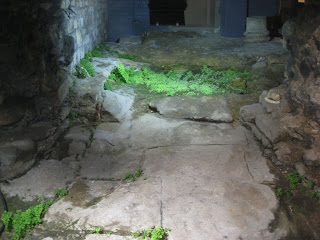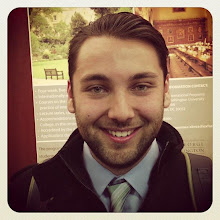Sunday, January 31, 2010
A Second Semester in Denmark
London
Here are some photos of all the amazing things I saw. I took the embarrassingly large quantity of 500 photos of London alone, so I had a hard time narrowing it down to these few. If you are ever curious to see the rest, feel free to ask me next time you see me. Or better yet, visit London if you can, because it is fantastic.
Westminster Abbey
Big Ben and the London Eye

Inside the reconstructed Globe Theater of Shakespeare
Along Fleet Street
St. Paul's Cathedral as seen from the Millennium Bridge
Trafalgar Square
St James's Park

Hyde Park

Buckingham Palace Gates
A War Memorial

London Bridge

Tower of London

Piccadilly Circus at night

Platform Nine-and-three-quarters, at King's Cross Station
"The Gherkin"
The Sherlock Holmes Museum, at 221b Baker Street
And finally the once home of our friend Friedrich Engels
Sunday, January 17, 2010
Oxford
The town itself is also very old, and was first occupied in Saxon times. It has many old buildings not associated with the university, as well as great museums and other cultural attractions. I had a great time visiting Oxford, and I am very jealous of my friends who have studied there, if for no other reason that it is extremely beautiful, and has so much history.
Stonehenge, Salisbury, and Bath
Our first stop was the Stonehenge Monument, which was built is several stages between 3,100 BCE and 1,930 BCE. It is one of the most recognizable Neolithic stone constructions, as well as one of the most controversial. Everyone has their own idea about what Stonehenge was, and who built it. All that being said, it was totally worth a visit, no matter how touristy it may be. I loved seeing the stones, it was very special.
Next we visited the Cathedral of Salisbury, which was built between 1220-1320 CE. It is an amazing church, which is currently being restored. It contains the oldest working clock in the world. It also houses one of the five remaining copies of the Magna Carta.
Finally, we got to the City of Bath, which is also a UNESCO World Heritage Site. It houses a natural hot spring, the waters of which have been thought to be magical and curative since before the Romans. The Romans built what is essentially a sauna there, as well as a temple. Then, in the Victorian Era, it became a resort town for the Royal Court. The nobility flocked to Bath to ‘Take the Waters’ in hopes of healing any number of ailments. Today you can still take the waters for 50p, which was an interesting experience. It is strangely warm, salty, and sulfurous. I think the best that can be said is that I didn’t get sick from it. It is a great city, full of Georgian and Victorian architecture, as well as an impressive church of its own. It was a great day outside of London, and a wonderful chance to see some of the English countryside, which is beautiful when covered in snow.
Taking the Waters
The River Avon
Friday, January 8, 2010
"There’s No Place Like London"
I have officially started my second short holiday of the winter season, this time in London, England. I was in Berlin, Germany last week with my parents, and I will be posting photos from that trip just as soon as I am back in Denmark. For now, I would like to keep you all filled in on my trip here in England. I will try to write as often as I can, but if I don’t, I will post everything at the end of the trip, next Friday.
This is the first time since august since I have been in a country where the ‘official’ language is English. I wasn’t sure how I would feel about it, and now that I am here, I still don’t. In fact, I’ve heard very little of the ‘Queen’s English’ since I got here. Sure, all of the signs are in English first, but still multiculturalism is all around me. When I arrived, I waited in the customs line with a group of Mandarin-speaking Chinese tourists. On the train, I was next to a group of Turks. I went out to what I thought was an Italian café for dinner, only to find the television was playing Croatian News and it is frequented by Frenchmen and Russians (or other Slavic-speakers, I wasn’t exactly sure). It is absolutely incredible how many different languages you hear here in London, and this has only been the first few hours.
I have also learned that you have to look the other way when crossing the street, as they drive on the left side of the road here. Somehow I forgot that in all the confusion of arriving in a city of over seven million people (more than ALL of Denmark). Thankfully however, in my neighborhood, instructions to look left or right are painted on the sidewalks, so I was saved from making any mistakes.
I’ll keep this blog short at I am planning on getting an early start to my sightseeing tomorrow morning. I will be sure to fill you all in on my adventures here just as soon as I can. Thankfully, I have wireless at my hotel, so it shouldn’t be too much of a problem. Until then…Cheers!
Wednesday, January 6, 2010
Jutland Adventures
The next morning we went to the small town of Jelling, which is the burial place of the first King of all Denmark, Gorm the Old. Gorm was originally buried in a Viking style burial mound, with many grave goods and even a stone ship. However, his son Harald Bluetooth moved him into a church next to the mound. Harald was the king who converted to Christianity. There is a very old stone church where Gorm is buried, and also a large rune-stone commissioned by Harad honoring his father. This stone also bears the first known representation of Christ in Scandinavia.
Gorm's Mound
Rune Stones
A Modern Version
Jelling Church
Our next stop was the small village of Stadil, on the west coast of Denmark. Stadil is the village where my great-grandmother lived before she immigrated to the United States with her parents. We visited the old family farm, Stougaard, as well as the Stadil Church.
Stougaard Farm
Stadil Church
Next, we made our way south along the coast, and stopped near the town of Hvide Sande to look at the North Sea.
Finally, we arrived in Ribe, which is the oldest town in Denmark. It was originally settles in… We saw the Ribe Cathedral, which is very beautiful, even from the outside.
Overall, it was a successful journey to Jutland. We saw a lot, but learned that there was even more we didn’t see. A lot was closed because of the holidays and the winter, which is not peak tourist season. Nevertheless, we saw a lot of very interesting things, many of them hundreds of years old. It is incredible how much happened there so many years ago, and how much of it remains today for visitors like us to see and enjoy.



















































